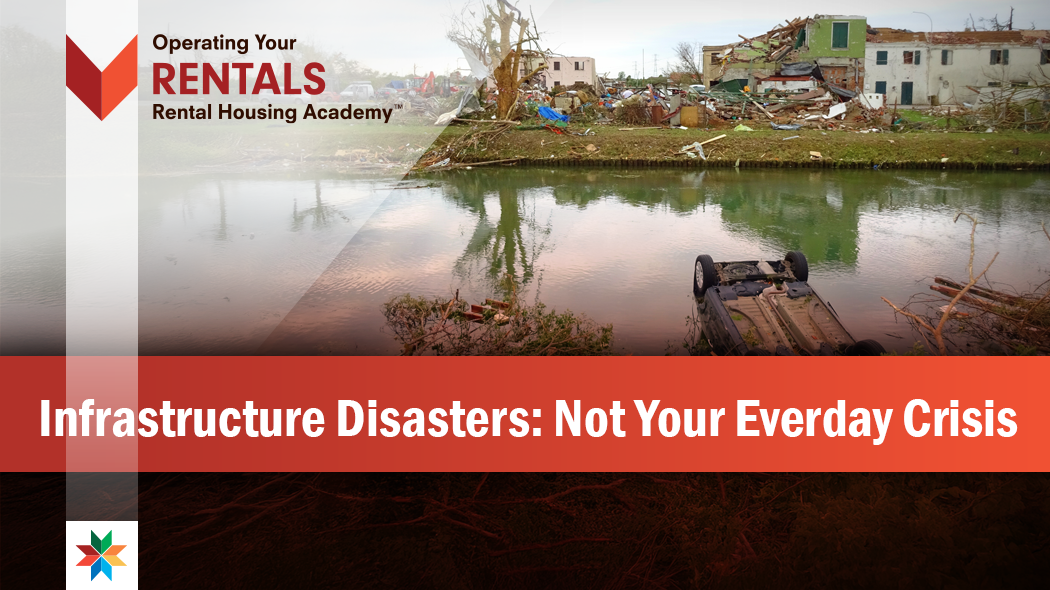INFRASTRUCTURE DISASTERS: Not Your Everyday Crisis
As a housing provider, you’re likely very good at managing plumbing leaks, kitchen fires, and other resident issues. You know how to communicate, prioritize, and marshal your resources.
Yet, large disasters impacting public infrastructure are likely not something you’ve experienced or given much thought.
To be clear, I’m not referring to the recent bomb cyclone or isolated wildfires. While not fun, you can likely rely on your normal problem-solving skills to figure out similar shorter-term events.
My focus for this article is on the long-term events that have the potential to damage your rental assets, weaken your business to the point of insolvency, and make future investment opportunities out of reach.

It’s true, some business risks are beyond your control and ability to mitigate. For example: Big rock hits planet – game over! Operating a business of any kind comes with some inherent risks that are not worth losing sleep over.
However, our modern world is too complex to assume your experience managing day-to-day resident disasters has prepared you for everything life can throw at you.
This is the point where I would typically throw in a bunch of stats and examples to convince you that this topic is worth your attention. But, in my experience that will only make your eyes glaze over! Please see the end of the article if you want local and national hazard assessment data.
Instead, I’m going to simply call out the elephant in the room.
At some point in time, all or a portion of the critical infrastructure supporting your rental business (e.g., water, sewer, electricity, natural gas, garbage collection, internet, phone, GPS, transportation, healthcare) will be interrupted for weeks or longer.
Depending on the threat, it may be regional, state, or nation-wide. There are many natural and human-made threats that could inflict this type of damage to the infrastructure supporting your business. Sorry East-siders, this is not limited to “The Big One.”
A lengthy infrastructure outage will happen. No one can predict the exact timing. Drop the mic.
Again, you’re a pro at dealing with day-to-day resident issues, but this is a different animal. In a lengthy interruption of public infrastructure, costly damage to your property and business may be the result of the lengthy disaster response and recovery and not the initial cause of the disaster.
For example, what if key services (e.g., water, sewer, natural gas, electricity) are damaged across your region and your rental property is untouched? How will your residents handle the bare necessities if they are camping in your rental for weeks or longer while service is restored, or temporary housing is made available?
Your lease probably has some language around “fit for occupancy.” But, if your residents have nowhere else to go and/or are told to “shelter-in-place” by authorities, your legal recourse is probably limited – even more than it is normally.
One can easily imagine a hazmat situation developing inside your rental property if sewage and garbage are not handled properly. If your plan is to order portable toilets, that’s probably not going to happen in a regional infrastructure disaster unless you’re extremely well connected or lucky.
Game over? No, don’t give up that easily. There are other practical actions you can take to contain the damage.
As Warren Buffet once said, “only when the tide goes out do you discover who's been swimming naked.” There are many regional risks in Washington state that could make the tide go out fast.
Let me help you find a bathing suit – if you’re a risk taker, even a speedo or bikini is a good start!
A simple start is to have a basic idea of what your business priorities are when dealing with a regional disaster – especially one that interrupts key housing infrastructure for weeks or longer.
In my experience, the more complicated you make your plan of attack, the more likely it will sit on your shelf and provide little/no value. So, here’s a simple one for a very capable housing provider like yourself:
Business Disaster Priorities
- The health and safety of your team and residents.
- Communicating with your key stakeholders.
- Preventing additional physical and financial damage to your business/assets.
- Providing your mission-critical rental services.
- Recovering your rental business back to normal operations.
To be clear, these are not steps, they are priorities. During a regional infrastructure disaster, the situation will be dynamic and unfold over time. Information may be limited. Having a list of priorities empowers you to make confident business decisions with incomplete information.
The faster you get off the sidelines and act, the more likely you are to procure the potentially scarce resources necessary to minimize the negative impact on your residents and rental business. How well you’re able to do this depends on what you’ve done ahead of time.
Have you developed the key relationships you’ll need to quickly react?
Do you know what key supplies you should procure to prevent a rental property hazmat situation?
What bad assumptions are you making about the impact of a regional infrastructure disaster on your business and family?
Join me on January 16th for RHAWA’s “Infrastructure Disasters: Not Your Everyday Crisis” where we’ll answer these questions and discuss practical ways you can prevent unnecessary damage to your property and keep your rental business solvent during large regional events.
Brad Krueger, MBA is a 5-star housing provider and property manager at The Joseph Group. He has over 15 years of risk, compliance, and crisis management experience and is an alumnus of the MiT Crisis Management and Business Continuity program. Find Brad Krueger on LinkedIn at: https://www.linkedin.com/in/bradkrueger/

